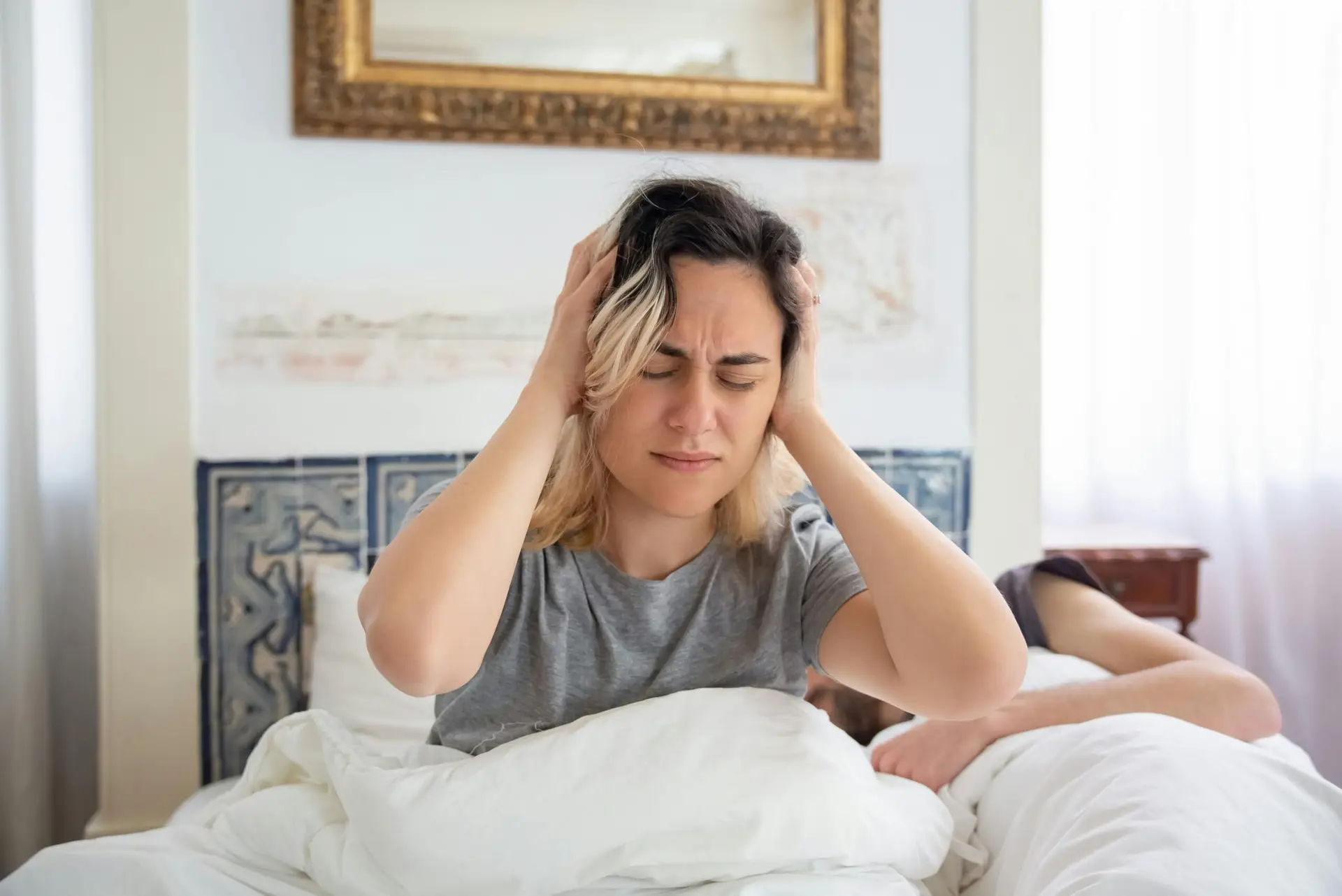
Clicking in My Ear: Tinnitus, often described as a ringing, buzzing, whooshing, or clicking sound in the ears, affects millions worldwide, with an estimated prevalence of 14.4% in the U.S. population based on National Health and Nutrition Examination Survey (NHANES) data from 2011–2020. For some, it’s a minor annoyance, but for others, it’s a debilitating condition that disrupts sleep, concentration, and quality of life. Among the various forms of tinnitus, pulsatile tinnitus—a rhythmic whooshing or clicking sound often synchronized with the heartbeat—stands out as particularly distressing.
At Lavender Family Chiropractic in Sarasota, Florida, we focus in addressing the root causes of tinnitus, including pulsatile tinnitus, through upper cervical chiropractic care. This blog post explores how misalignments in the upper cervical spine can contribute to tinnitus, the role of blood flow, and how our expert chiropractors help patients find relief. We’ll also discuss related conditions like vertigo, Meniere’s disease, vestibular neuritis, and other vestibular dysfunctions, offering a comprehensive guide to understanding and managing these issues naturally.
Clicking in My Ear: Understanding Tinnitus and Pulsatile Tinnitus
Tinnitus is not a disease but a symptom of an underlying issue, characterized by the perception of sound without an external source. Common descriptions include ringing, buzzing, humming, whooshing, or clicking. Pulsatile tinnitus, a subtype affecting about 1–2% of tinnitus sufferers, is unique because the sound often aligns with the heartbeat, creating a rhythmic whooshing or clicking sensation. This type is frequently linked to vascular issues, such as turbulent blood flow or pressure on blood vessels near the ear.
Common Causes of Tinnitus
Tinnitus can stem from various factors, including:
- Hearing loss: Damage to inner ear hair cells, often due to aging or noise exposure.
- Ear infections or blockages: Wax buildup or fluid in the middle ear.
- Medications: Certain drugs, like aspirin or antibiotics, can trigger tinnitus as a side effect.
- Head or neck injuries: Trauma can disrupt nerve signals or blood flow.
- Neurological or vascular issues: Conditions affecting the auditory or circulatory systems.
Pulsatile tinnitus, in particular, is often associated with:
- Blood vessel abnormalities: Narrowed or stiffened arteries, such as the carotid artery.
- Increased intracranial pressure: Conditions like idiopathic intracranial hypertension.
- Upper cervical spine misalignments: Disruptions to blood flow or nerve function.
At Lavender Family Chiropractic, we focus on the often-overlooked connection between tinnitus and upper cervical spine misalignments, which can significantly impact blood flow and nerve function, leading to symptoms like clicking or whooshing in the ear.
The Upper Cervical Spine: A Key Player in Tinnitus
The upper cervical spine, comprising the atlas (C1) and axis (C2) vertebrae, is the topmost portion of the spine, located just below the skull. This region is critical for several reasons:
- It supports the head, allowing for a wide range of motion.
- It houses the brainstem, a vital structure that relays signals between the brain and body, including those related to hearing and balance.
- It is surrounded by major blood vessels, such as the carotid and vertebral arteries, which supply blood to the brain and inner ear.
How Misalignments Cause Tinnitus
Misalignments in the upper cervical spine, often resulting from whiplash, sports injuries, poor posture, or even minor repetitive strain, can disrupt the delicate balance of this region. Here’s how these misalignments contribute to tinnitus:
- Nerve Irritation:
- The vestibulocochlear nerve (cranial nerve VIII), responsible for hearing and balance, connects to the brainstem. Misalignments in the atlas or axis can place pressure on the brainstem or nerve, interfering with auditory signal processing. This disruption may manifest as tinnitus, including the clicking or whooshing sounds of pulsatile tinnitus.
- Research suggests that upper cervical misalignments can lead to stapedius muscle spasms in the inner ear, which dampen loud noises. These spasms can trigger clicking or ringing sensations.
- Impaired Blood Flow:
- The vertebral arteries, which run through the cervical spine, supply blood to the brainstem, inner ear, and auditory system. A misalignment can compress or irritate these arteries, reducing blood flow or causing turbulent flow, which is often perceived as pulsatile tinnitus.
- Compression of the carotid artery, located near the cervical spine, can also contribute to pulsatile tinnitus by altering blood flow dynamics near the ear.
- Cerebrospinal Fluid (CSF) Flow Disruption:
- Misalignments may affect the flow of CSF, which cushions the brain and spinal cord. Altered CSF dynamics can increase intracranial pressure, potentially contributing to pulsatile tinnitus or related symptoms like ear fullness.
- Muscle Tension:
- Misalignments often lead to tension in the neck and jaw muscles, including those near the temporomandibular joint (TMJ). This tension can exacerbate tinnitus, particularly when jaw or neck movements alter the sound’s intensity.
Case Studies and Evidence
- A 2010 case study published in the Journal of Manipulative and Physiological Therapeutics described a woman with Meniere’s disease and left-sided tinnitus who experienced complete resolution of her tinnitus within two weeks of upper cervical chiropractic care.
- A 2012 study in the Journal of Upper Cervical Chiropractic Research reported a 52-year-old man with Meniere’s disease and tinnitus who saw a 60% improvement in symptoms after five weeks of upper cervical adjustments.
- Anecdotal evidence from patients at Lavender Family Chiropractic supports these findings, with many reporting reduced tinnitus intensity or complete resolution after addressing upper cervical misalignments.
The Role of Blood Flow in Tinnitus
Blood flow is a critical factor in pulsatile tinnitus, as the rhythmic whooshing or clicking often reflects vascular changes. The inner ear is highly sensitive to blood supply, relying on the vertebral and carotid arteries for oxygen and nutrients. When upper cervical misalignments occur, they can:
- Compress blood vessels: Reducing blood flow to the inner ear, leading to auditory disturbances.
- Cause turbulent flow: Irregular blood flow patterns can create audible whooshing or clicking sounds, especially in pulsatile tinnitus.
- Increase vascular pressure: Misalignments may contribute to conditions like hypertension or intracranial pressure, exacerbating tinnitus.
Upper cervical chiropractic care aims to restore proper alignment, relieving pressure on blood vessels and improving circulation. Enhanced blood flow supports the health of the inner ear and auditory system, often reducing or eliminating tinnitus symptoms. At Lavender Family Chiropractic, our precise adjustments target these misalignments, promoting optimal vascular function and nervous system communication.
Lavender Family Chiropractic: Your Partner in Tinnitus Relief
Located in Sarasota, Florida, Lavender Family Chiropractic is a leader in upper cervical chiropractic care, offering a natural, non-invasive approach to managing tinnitus and related conditions. Our experienced doctors, trained in advanced upper cervical techniques like Blair Chiropractic, are dedicated to identifying and correcting the root causes of your symptoms.
Why Choose Lavender Family Chiropractic?
- Specialized Expertise:
- Our chiropractors are highly skilled in assessing and correcting upper cervical misalignments using precise, gentle techniques. We use advanced diagnostic tools, such as digital X-rays and 3D imaging (CBCT), to pinpoint the exact location and degree of misalignment.
- We tailor each treatment plan to the patient’s unique anatomy, ensuring effective and lasting results.
- Proven Results:
- Over the years, we’ve helped thousands of patients find relief from tinnitus, pulsatile tinnitus, and associated symptoms like vertigo and ear fullness. Many report significant improvements after just a few adjustments.
- Our focus on the upper cervical spine addresses the underlying causes of tinnitus, rather than masking symptoms with medications or sound therapy.
- Holistic Approach:
- We view the body as an interconnected system, addressing not only tinnitus but also related issues like neck pain, headaches, and balance disorders. Our care supports overall wellness, helping patients reclaim their quality of life.
- We offer complimentary consultations to discuss your symptoms and explore how upper cervical care can help.
- Patient-Centered Care:
- At Lavender Family Chiropractic, we prioritize patient education and empowerment. Our team takes the time to explain your condition, the role of the upper cervical spine, and the expected outcomes of care.
- We monitor progress closely, adjusting treatment plans as needed to ensure the correction holds and the body heals naturally.
Our Process
- Comprehensive Evaluation:
- We begin with a detailed medical history and physical examination to understand your symptoms and health concerns.
- Advanced imaging, such as CBCT scans, allows us to visualize the alignment of your atlas and axis vertebrae with precision.
- Customized Treatment Plan:
- Based on your evaluation, we develop a personalized plan that includes gentle upper cervical adjustments to restore alignment.
- Adjustments are performed using low-force techniques, avoiding twisting or popping, for a comfortable and safe experience.
- Ongoing Monitoring:
- We track your progress through follow-up visits and neurological tests to ensure the adjustment holds and symptoms improve.
- Our goal is to reduce the need for frequent adjustments as your spine stabilizes and your body heals.
Patient Success Stories
- A 45-year-old Sarasota resident visited Lavender Family Chiropractic with pulsatile tinnitus and vertigo following a car accident. After six weeks of upper cervical care, her whooshing sounds resolved, and her balance improved dramatically.
- A 60-year-old patient with chronic tinnitus and neck pain reported a 70% reduction in ringing intensity after three months of care, allowing him to sleep better and focus at work.
If you’re struggling with clicking or whooshing in your ear, contact Lavender Family Chiropractic today for a complimentary consultation. Our Sarasota office is here to help you find lasting relief.
Tinnitus and Related Vestibular Conditions
Tinnitus often coexists with vestibular disorders, which affect balance and spatial orientation. These conditions share a common link with the upper cervical spine and vestibulocochlear nerve, making upper cervical chiropractic care a valuable treatment option. Below, we explore vertigo, Meniere’s disease, vestibular neuritis, and other vestibular dysfunctions.
1. Vertigo
Vertigo is the sensation that you or your surroundings are spinning, often triggered by head movements. It can result from:
- Benign Paroxysmal Positional Vertigo (BPPV): Dislodged calcium carbonate crystals in the inner ear disrupt balance signals.
- Cervicogenic vertigo: Caused by upper cervical misalignments affecting the brainstem or vestibular nerve.
- Post-traumatic vertigo: Common after head or neck injuries, such as whiplash.
Upper Cervical Connection:
- Misalignments can irritate the vestibular nerve or disrupt brainstem function, leading to faulty balance signals.
- A study involving 139 patients with Meniere’s disease found that 97% experienced significant vertigo improvement after upper cervical adjustments.
- At Lavender Family Chiropractic, we’ve seen patients with vertigo regain stability after correcting C1-C2 misalignments.
2. Meniere’s Disease
Meniere’s disease is a chronic inner ear disorder characterized by:
- Episodic vertigo lasting minutes to hours.
- Tinnitus, often low-pitched or whooshing.
- Hearing loss, typically in one ear.
- Aural fullness (pressure in the ear).
The condition is thought to involve fluid buildup (endolymphatic hydrops) in the inner ear, but upper cervical misalignments may exacerbate symptoms by:
- Irritating the brainstem, which regulates inner ear function.
- Disrupting CSF or blood flow, increasing inner ear pressure.
Upper Cervical Care:
- A 2010 case report described a 40-year-old woman with Meniere’s disease whose tinnitus, vertigo, and neck pain resolved after upper cervical adjustments.
- Our Sarasota chiropractors use precise adjustments to reduce nerve irritation and improve inner ear function, offering relief for Meniere’s symptoms.
3. Vestibular Neuritis
Vestibular neuritis is an inflammation of the vestibular nerve, often caused by viral infections, leading to:
- Sudden, severe vertigo.
- Dizziness and imbalance.
- Nausea and difficulty concentrating.
While the condition may resolve on its own, lingering symptoms can persist if upper cervical misalignments are present, as they impair vestibular nerve function.
Upper Cervical Care:
- By correcting misalignments, we reduce pressure on the vestibular nerve, promoting healing and restoring balance.
- Lavender Family Chiropractic has helped Sarasota patients with vestibular neuritis achieve long-lasting relief through targeted adjustments.
4. Other Vestibular Dysfunctions
Other balance disorders, such as labyrinthitis (inflammation of the inner ear) or post-concussion syndrome, can also involve tinnitus and dizziness. These conditions often stem from:
- Trauma to the head or neck.
- Upper cervical misalignments affecting the brainstem or cranial nerves.
- Impaired blood flow or CSF dynamics.
Upper Cervical Care:
- Our chiropractors address the structural and neurological components of these disorders, helping patients regain balance and reduce tinnitus.
- Regular adjustments support the body’s natural healing process, offering a drug-free alternative to symptom management.
How Upper Cervical Chiropractic Addresses Tinnitus and Vestibular Issues
Upper cervical chiropractic care is a targeted, non-invasive approach that focuses on restoring alignment to the atlas and axis vertebrae. Here’s how it works:
- Restoring Nervous System Function:
- Adjustments relieve pressure on the brainstem and vestibulocochlear nerve, improving auditory and balance signal processing.
- This can reduce tinnitus sounds and stabilize balance in conditions like vertigo or Meniere’s disease.
- Enhancing Blood Flow:
- Proper alignment ensures unobstructed blood flow through the vertebral and carotid arteries, reducing pulsatile tinnitus and supporting inner ear health.
- Improved circulation aids in tissue repair and reduces inflammation.
- Reducing Muscle Tension:
- Adjustments alleviate tension in the neck and jaw, which can exacerbate tinnitus, especially in cases linked to TMJ dysfunction.
- Relaxed muscles improve overall comfort and reduce symptom intensity.
- Promoting Healing:
- By removing nerve interference and optimizing spinal alignment, upper cervical care allows the body to heal naturally, addressing the root causes of tinnitus and vestibular dysfunction.
At Lavender Family Chiropractic, our Blair Chiropractic technique emphasizes precision and gentleness, making it suitable for patients of all ages. We’ve seen remarkable results in Sarasota, with patients reporting reduced tinnitus, improved balance, and enhanced well-being.
Lifestyle Tips to Support Tinnitus and Vestibular Health
In addition to upper cervical care, adopting healthy habits can enhance your recovery and reduce symptoms:
- Manage Stress: Chronic stress can worsen tinnitus and vertigo. Practice relaxation techniques like deep breathing, meditation, or yoga.
- Protect Your Ears: Avoid loud noises and use ear protection in noisy environments to prevent further damage.
- Stay Hydrated: Proper hydration supports inner ear fluid balance, especially in Meniere’s disease.
- Maintain Good Posture: Proper posture reduces strain on the cervical spine, preventing misalignments.
- Limit Caffeine and Sodium: These can exacerbate tinnitus or fluid retention in Meniere’s disease.
- Exercise Regularly: Gentle exercises, like walking or stretching, improve blood flow and support nervous system health.
Consult with your Lavender Family Chiropractic doctor for personalized recommendations tailored to your condition.
Why Upper Cervical Care is a Game-Changer
Tinnitus, pulsatile tinnitus, vertigo, Meniere’s disease, vestibular neuritis, and other vestibular dysfunctions can feel overwhelming, but they don’t have to control your life. At Lavender Family Chiropractic in Sarasota, Florida, we offer a natural, effective solution through upper cervical chiropractic care. By addressing misalignments in the atlas and axis vertebrae, we restore nervous system function, improve blood flow, and promote healing, helping patients find relief from clicking, whooshing, and balance issues.
Take the First Step Toward Relief
If you’re tired of living with the whooshing or clicking of tinnitus or the spinning of vertigo, it’s time to explore upper cervical care. Schedule a complimentary consultation with Lavender Family Chiropractic today. Our expert chiropractors will assess your condition, explain how misalignments may be contributing to your symptoms, and develop a personalized plan to help you reclaim your health.
Schedule With Us!
Lavender Family Chiropractic in Sarasota Florida offers complimentary consultations to learn more about you. Click the link below!
https://intake.chirohd.com/new-patient-scheduling/724/lavender-family-chiropractic
Visit our Website!
To learn more about us go to http://www.chiropractorsarasotaflorida.com
We also service Bradenton, Parrish, Ellenton, Ruskin, Venice, Tampa, St. Pete, Osprey, Longboat, Lakewood Ranch, Myakka City.
If you are not local, visit www.uccnearme.com to find a doctor in your area.
Don’t let tinnitus or vestibular issues hold you back. With Lavender Family Chiropractic, relief is within reach. Let us help you silence the noise and restore your balance—naturally.





